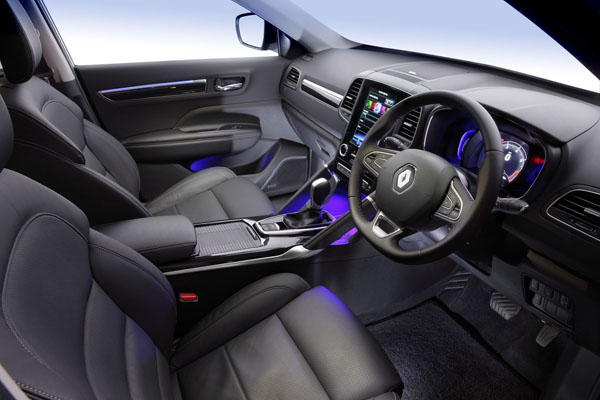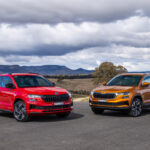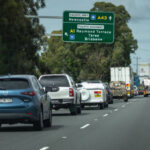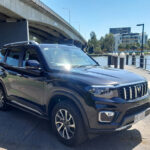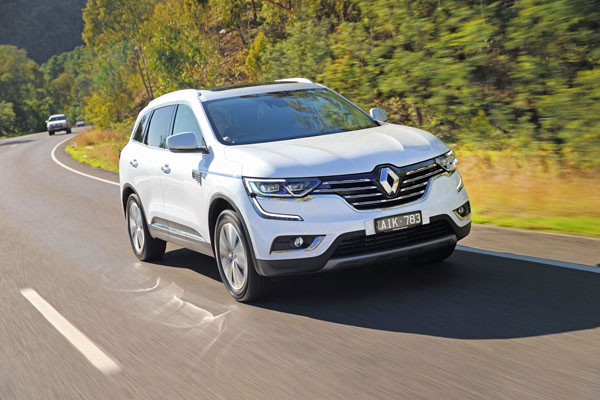
When the tsunami of sports utility vehicles started hitting shores around the globe, Renault, in fear of being swamped by the fast expanding market, called on a partner to help fill the gap.
The French automobile giant, already in an alliance with Nissan, was able to morph its Koleos crossover into a mid-size SUV using the Japanese company’s X-Trail as a base.
Lucky for us, Australia was the first market to receive the new SUV, which was to become Renault’s best-selling vehicle Down Under. Now the MY18 Koleos has been given a kick-along by the addition of the latest automotive safety features.
Advanced Emergency Braking System, as well as Apple CarPlay, have been introduced across the range.
STYLING
With the second generation, the Koleos left its outdated box-like multi-purpose vehicle styling behind and took on the outward features of the latest SUV.
Koleos carries a prominent Renault badge in the centre of a broad chrome grille. The muscular bonnet lines have several chrome embellishments, including strips that run from the headlights along the full length of the guards to visually lengthen the front end and, Renault tells us, “impart dynamism and elegance”.
With a 2705 mm wheelbase and total vehicle length of 4672 mm it’s among the longest in class.
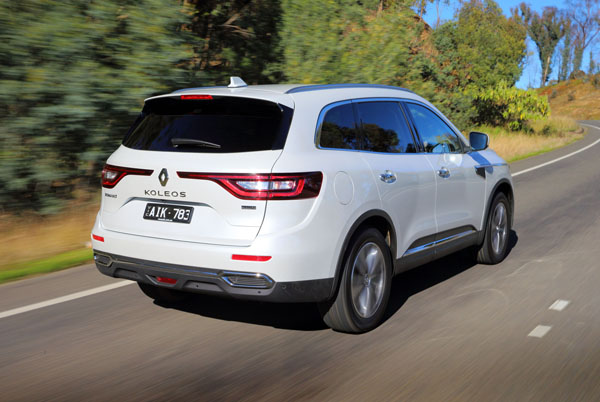 INTERIOR
INTERIOR
Inside the SUV looks have a quality usually seen only in a large prestige family sedan.
Occupants can settle into firm yet comfortable seating with dark carbon cloth upholstery. Dual zone climate control air-conditioning makes for a pleasant journey, while front LED cabin lights add further atmosphere and front centre storage console with sliding armrest takes care of accompanying stuff.
INFOTAINMENT
All Koleos variants now boast Apple CarPlay and Android Auto smartphone operation, obtained through the Renault R-Link 2 satellite navigation system via a 7.0-inch or 8.7-inch touchscreen depending on the model.
The 7.0-inch landscape screen in our test car offers the same functions as a tablet – two-finger zoom, swipe page scrolling, and drag and drop.
Voice recognition is on hand for navigation instructions and telephone use. Arkamys audio with eight speakers, provides quality sound.
ENGINES / TRANSMISSIONS
The all-aluminium 2.5-litre four-cylinder engine produces maximum power of 126 kW at 5000 rpm and full torque of 226 Nm at 4400 rpm. Coupled with an advanced X-Tronic continuously variable transmission it combines the smooth step-less nature of a CVT, but has steps to make if feel like a standard automatic if your that way inclined.
Manual mode offers a more dynamic drive if you are a keen driver.
SAFETY
Using forward-facing radar, the advanced emergency braking system is designed to reduce the risk of smashes if a vehicle in front should suddenly slow down or stop.
The system warns the driver audibly and visually and, if needed, applies the brakes through the electronic stability control system. If, despite the warning, the driver does not slow down to increase the distance from the potential risk, the system will brake automatically.
If the driver brakes but doesn’t do so hard enough the car takes over and adds more braking force of around 20 to 30 per cent is applied without any change in the feel of the brake pedal.
If the driver fails to brake despite the hazard, the system brakes automatically for up to two seconds. During this time the brake lights are switched on automatically.
Driver and front passenger are protected by adaptive airbags, plus lateral pelvis and chest-level airbags. Included are front and rear curtain airbags. Hill start assist aids setting off on inclines.
Rear sensors and rear-view camera help when parking and cornering-function fog lights illuminate the road when turning.
DRIVING
The 2.5-litre naturally aspirated petrol engine tries hard to keep up with the workload while pushing the 1.5 tonne-plus two-wheel drive Koleos Life around in varied road conditions.
By all accounts, the recently-added 2.0-litre turbo-diesel Koleos Intens model, with all-wheel drive, does the job better. But there’s an added cost of $16,000 on purchase for that option.
The test petrol-powered Life put in a fairly frugal fuel performance, averaging just over 8 litres per 100 kilometres across a range of on-road driving from crowded city streets to free-rein highway stuff.
Most impressive was the amount of room for passengers and luggage: with all five seats taken, there is still 458 litres of cargo space in the back, while with both rear seat backs folded, this increases to an extremely generous 1690 litres, matching many upscale rivals.
The aforementioned emergency braking system gives the driver a confidence boost, especially in city traffic, while the addition of Apple CarPlay to Android Auto connectivity keeps touch with the requirements of modern-day motoring.
SUMMING UP
It has to be said, Renault Koleos comes into a heavily congested market and will need all the help from the latest in automotive technology to get big sales. However, the roomy Renault has plenty to offer in the space race.
AT A GLANCE
MODEL LINE-UP
Koleos Life 2WD (CVT): $30,990
Koleos Zen 2WD (CVT): $35,490
Koleos Zen 4WD (CVT): $37,990
Koleos Intens 4WD (CVT): $44,990
Koleos Intens diesel 4WD (CVT): $47,490
Koleos Initiale 4WD (CVT): $45,490
Note: These prices do not include government or dealer delivery charges. Contact your local Renault dealer for drive-away prices.
SPECIFICATIONS (Koleos Life 2.5-litre petrol CVT 4×2 five-seater SUV)
ENGINE:
Capacity: 2.488 litres
Configuration: Four cylinders in line
Maximum Power: 126 kW @ 5000 rpm
Maximum Torque: 226 Nm @ 4400 rpm
Fuel Type: Petrol 95 RON
Combined Fuel Cycle (ADR 81/02): 8.1 L/100km
CO2 Emissions: 188 g/km
DRIVELINE: X-Tronic CVT automatic
DIMENSIONS, WEIGHT AND CAPACITIES:
Length: 4672 mm
Wheelbase: 2705 mm
Width: 1834 mm
Height: 1678 mm
Turning Circle: 11.4 metres
Kerb Mass: 1552 kg
Fuel Tank Capacity: 60 litres
BRAKES:
Front: Ventilated disc
Rear: Solid disc
STANDARD WARRANTY:
Five years / unlimited kilometres




